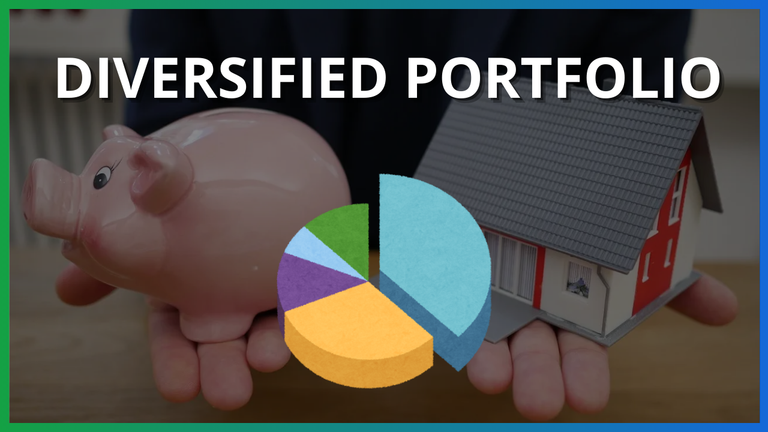
We often find ourselves comparing the returns of one asset class with those of a completely different investment class. Whoever has never compared the dividends of a real estate fund with the dividends of stocks, or even with the returns of fixed income, cast the first stone. This is a subject that confuses many investors and that is why we are going to talk a little about the comparison of assets and the real return of real estate funds.
💵 Real Return - FIIs x Fixed Income x Stocks
📊 Importance of a Diversified Portfolio
👉 Let's talk about Featured Assets! News about 🏠Real Estate Funds, 📈 Shares and of course the 📰Economic Scenario that has an impact on these assets, such as Interest Rates, Inflation... 🛑 Remembering that it is not an Investment Recommendation!
I'll be much appreaciated if you Upvote, Reblog or give any Tips ( PIZZA 🍕, PGM 🎮, LOLZ 😆, ALIVE ❤️, etc ). Thanks and have good reading! 🍀

[ENGLISH VERSION]
💵 Real Yield - FIIs x Fixed Income x Stocks 💵

An extremely important point to be taken into consideration when you think about the real yield of any financial investment is the issue of inflation of the currency it is in. In Brazil, the Brazilian Institute of Geography and Statistics, IBGE, calculates the inflation of the Real (R$) through the IPCA index, which takes a basket of products to measure the price variation in the period. On the IBGE website, we can see that inflation in the last 12 months was 4.42%, which could mean that all the money you have is worth this percentage less.

Therefore, when comparing dividends and returns from a fixed income with the returns from a variable income, such as real estate funds, investors and beginners do not always take inflation into account. In fixed income, since you leave your money idle, often yielding 100% of the CDI, that is, the Selic interest rate, the IPCA would have to be discounted to arrive at the real yield. The Central Bank of Brazil reports that the current rate is 10.75%, but that is not the real yield. In reality, you would be receiving 10.75% - 4.42% (IPCA), reaching 6.33%. This is an calculation that is not always made and that applies to investments in reais as well as in any currency, considering the interest rate/profitability and discounting inflation.

The interesting thing about brick real estate funds is that shopping malls, warehouses, corporate slabs, among others, are properties that can absorb inflation. This means that the dividends paid by real estate funds are theoretically free from inflation, since these assets are revalued from time to time, causing the values of the properties to be adjusted. The important thing is for you, the investor, to be aware of this, since these asset revaluations happen. In addition, the rents themselves are also adjusted by indexes.

This is why making direct comparisons between asset classes and especially only looking at profitability is not the right way. There is no point in looking for stocks that pay monthly dividends, if they normally pay for longer periods, for that we have real estate funds. After all, they are different asset classes, with different proposals and different risks. Real estate funds are linked to the real estate sector, shares and companies distribute a percentage of profits, but make reinvestments, fixed income has to consider inflation and is linked to a rate that can rise or fall. That's why it's important to have a diversified portfolio.
📊 Importance of a Diversified Portfolio 📊

For any investor who is starting out, one way to get off to a good start is to form a diversified portfolio of assets that is close to the investor's profile, which is capable of protecting you against possible unforeseen events in a given sector or investment class. To do this, the best thing to do is to study a lot, read some very good books on the subject, such as The Intelligent Investor by Benjamin Graham, which addresses two types of approach, one more defensive and talks about other subjects such as margin of safety, etc.
In addition, starting small is essential to get into the habit of investing and choosing the assets to invest in. Not staying in theory and moving on to practice makes a big difference. The sooner you start, the better because it is a sequence of changes. You will pay more attention to the assets you have chosen, more attention to the news and be more analytical, thinking about how that news and change can affect your real estate fund, stock, fixed income.


Diversas vezes nos vemos comparando rendimentos de uma classe de ativos com os de outra classe de investimento completamente diferente. Quem nunca comparou os dividendos de um fundo imobiliário com os dividendos de ações, ou até mesmo com os rendimentos da renda fixa, que atire a primeira pedra. Esse é um assunto que confunde muitos investidores e por isso vamos falar um pouco sobre a comparação de ativos e o rendimento real dos fundos imobiliários.
💵 Rendimento Real - FIIs x Renda Fixa x Ações
📊 Importância de uma Carteria Diversificada
👉 Vamos falar sobre Ativos em Destaque! Novidades sobre 🏠Fundos Imobiliários, 📈 Ações e claro do 📰Cenário Econômico que tanto impacta esses ativos, como a Taxa de Juros, Inflação... 🛑 Lembrando que não é uma Recomendação de Investimentos!
Fico agradecido se você upder dar um Upvote, Reblog ou algum Tips ( PIZZA 🍕, PGM 🎮, LOLZ 😆, ALIVE ❤️, etc ). Obrigado e boa leitura! 🍀

[VERSÃO PORTUGUÊS]
💵 Rendimento Real - FIIs x Renda Fixa x Ações 💵

Um ponto de extrema importância a ser levado em consideração quando você for pensar em rendimento real de qualquer investimento financeiro é a questão da inflação da moeda que ele está. No Brasil o Instituto Brasileiro de Geografia e Estatística, o IBGE, faz o cálculo da inflação do Real (R$) através do índice IPCA, que pega uma cesta de produtos para medir qual foi a variação de preços no período. No site do IBGE, podemos observar que a inflação nos últimos 12 meses foi de 4,42%, isso pode representar que todo o dinheiro que você tem vale essa porcentagem a menos.

Assim, quando é comparado os dividendos e retornos de uma renda fixa com os retornos de uma renda variável, como por exemplo os fundos imobiliários, nem sempre os investidores e os iniciantes levam em conta a Inflação. Na renda fixa como você deixa o dinheiro parado muitas vezes rendendo 100% do CDI, ou seja, a Taxa de Juros Selic basicamente, teria que ser descontado o IPCA para chegar no rendimento real. No Banco Central do Brasil é informado que a taxa hoje é 10,75%, mas não é esse o rendimento real. Na realidade, você estaria recebendo 10,75% - 4,42% (IPCA), chegando em 6,33%. Essa é uma conta que nem sempre é feita e que vale tanto para investimentos no real como em qualquer moeda, vê a taxa de juros/rentabilidade e desconta a inflação.

O interessante nos fundos imobiliários de Tijolo é que os Shoppings, Galpões, Lajes Corporativas, entre outros, são imóveis que conseguem absorver a inflação. Isso significa que os Dividendos pagos pelos fundos imobiliários são teoricamente livres de inflação, já que de tempos em tempos é feito uma reavaliação desses ativos, fazendo com que os valores dos imóveis sejam corrigidos. O importante é você investidor ter consciência disso, já que essa reavaliações patrimoniais acontecem. Além disso, os próprios alugueis são reajustados por índices também.

É por isso que fazer comparações diretas entre classes de ativos e principalmente só olhando a rentabilidade não é a forma correta. Não adianta procurar ações que pagam dividendos mensais, se normalmente elas pagam por períodos maiores, para isso temos os fundos imobiliários. Afinal, são classes de ativos diferentes, com propostas diferentes e riscos diferentes, os fundos imobiliários são ligados ao setor imobiliário, ações e empresas distribuem um percentual dos lucros, mas realizam reinvestimentos, renda fixa tem que considerar inflação e está atrelada a uma taxa que pode subir ou cair. Por isso que é importante ter uma carteira diversificada.
📊 Importância de uma Carteria Diversificada 📊

Para todo investidor que esteja começando uma forma de começar bem é formar uma carteira de ativos diversificada que seja próxima do perfil do investidor, que seja capaz de te proteger contra eventuais imprevistos em um determinado setor ou classe de investimento. Para isso, o mais recomendado é estudar bastante, ler alguns livros muito bons sobre esse assunto como o do Investidor Inteligente de Benjamin Graham, que aborda dois tipos de abordagem, uma mais defensiva e fala sobre outros diversos assuntos como margem de segurança e etc.
Além disso, começar com pouco é fundamental para já ir pegando o hábito de investir, de escolher os ativos para aportar. Não ficar na teoria e partir para a prática faz muita diferença, quanto mais cedo você começar, melhor será porque é uma sequência de mudanças, você vai prestar mais atenção nos ativos que escolheu, mais atenção nas notícias e ser mais analítico pensando em como aquela notícias e mudança pode afetar aquele seu fundo imobiliário, ação, renda fixa.


If you like Finance, Crypto, Play2Earn or Anime content, consider FOLLOW me, that way you'll receive a notification when new post is done.
Assets generate passive income and guarantee a great future! 🚀💰
Posted Using InLeo Alpha
